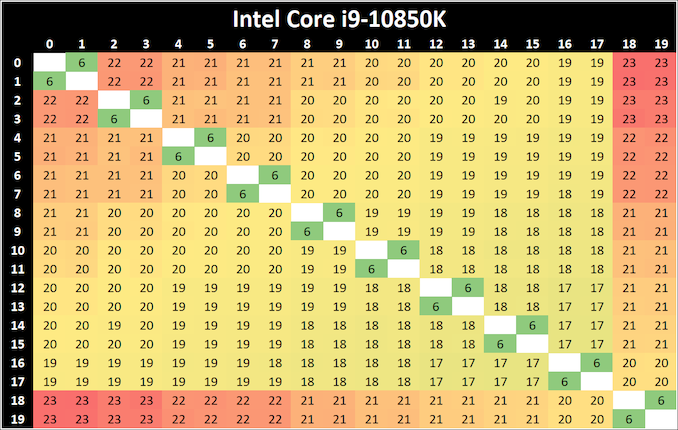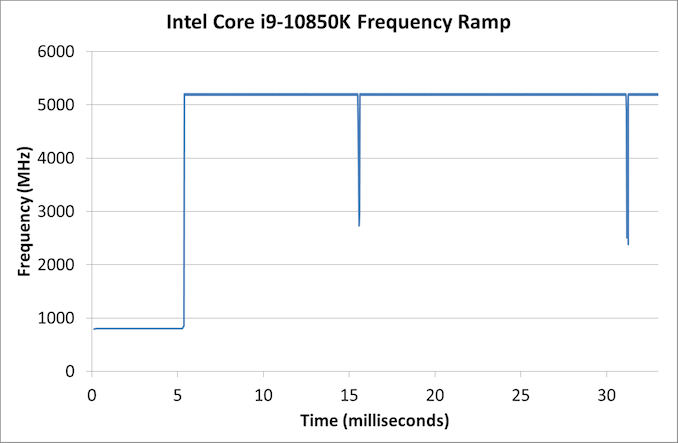Intel Core i9-10850K Review: The Real Intel Flagship
by Dr. Ian Cutress on January 4, 2021 9:00 AM EST- Posted in
- CPUs
- Intel
- Core
- Z490
- 10th Gen Core
- Comet Lake
- LGA1200
- i9-10850K
CPU Tests: Microbenchmarks
Core-to-Core Latency
As the core count of modern CPUs is growing, we are reaching a time when the time to access each core from a different core is no longer a constant. Even before the advent of heterogeneous SoC designs, processors built on large rings or meshes can have different latencies to access the nearest core compared to the furthest core. This rings true especially in multi-socket server environments.
But modern CPUs, even desktop and consumer CPUs, can have variable access latency to get to another core. For example, in the first generation Threadripper CPUs, we had four chips on the package, each with 8 threads, and each with a different core-to-core latency depending on if it was on-die or off-die. This gets more complex with products like Lakefield, which has two different communication buses depending on which core is talking to which.
If you are a regular reader of AnandTech’s CPU reviews, you will recognize our Core-to-Core latency test. It’s a great way to show exactly how groups of cores are laid out on the silicon. This is a custom in-house test built by Andrei, and we know there are competing tests out there, but we feel ours is the most accurate to how quick an access between two cores can happen.
When we first reviewed the 10-core Comet Lake processors, we noticed that a core (or two) seemed to take slightly longer to ping/pong than the others. We see the same pattern here again with the final core.
Frequency Ramping
Both AMD and Intel over the past few years have introduced features to their processors that speed up the time from when a CPU moves from idle into a high powered state. The effect of this means that users can get peak performance quicker, but the biggest knock-on effect for this is with battery life in mobile devices, especially if a system can turbo up quick and turbo down quick, ensuring that it stays in the lowest and most efficient power state for as long as possible.
Intel’s technology is called SpeedShift, although SpeedShift was not enabled until Skylake.
One of the issues though with this technology is that sometimes the adjustments in frequency can be so fast, software cannot detect them. If the frequency is changing on the order of microseconds, but your software is only probing frequency in milliseconds (or seconds), then quick changes will be missed. Not only that, as an observer probing the frequency, you could be affecting the actual turbo performance. When the CPU is changing frequency, it essentially has to pause all compute while it aligns the frequency rate of the whole core.
We wrote an extensive review analysis piece on this, called ‘Reaching for Turbo: Aligning Perception with AMD’s Frequency Metrics’, due to an issue where users were not observing the peak turbo speeds for AMD’s processors.
We got around the issue by making the frequency probing the workload causing the turbo. The software is able to detect frequency adjustments on a microsecond scale, so we can see how well a system can get to those boost frequencies. Our Frequency Ramp tool has already been in use in a number of reviews.
The Core i9-10850K ramps up extremely quickly from idle to peak turbo, in the region of about 5 milliseconds. This is faster than the 16 ms we typically observe.












126 Comments
View All Comments
1_rick - Monday, January 4, 2021 - link
Because you've got the people who will spend any amount of money to get 5fps more in their games so they can smugly tell everyone who they've got the best.lopri - Monday, January 4, 2021 - link
I see Ryzens beating this thing by sizeable margins in games.zodiacfml - Monday, January 4, 2021 - link
Ryzen 5000 series is significantly faster than Intel's i9-10900k in all games though I haven't seen compared with overclocks. The Intel gets good at rendering/encode but I'd rather buy old Xeons with Chinese motherboards for those loadsV3ctorPT - Monday, January 4, 2021 - link
In gaming the real star is the 5600X... awesome performance for its price, for a 65W(!) CPU...lmcd - Monday, January 4, 2021 - link
It's basically an 80W CPU though lolCrazyeyeskillah - Monday, January 4, 2021 - link
my 5600x is 10-20c hotter than my 3600 clock for clock on the same exact rig and watercooler.JessNarmo - Monday, January 4, 2021 - link
I was considering 10850k as an upgrade option when I it for $400. It's undeniably significantly better deal than 10900k at $530.But ultimately decided that it's just not good enough for an upgrade because it still doesn't support PCIE 4 so if I upgrade I would have to upgrade again very shortly.
Would have to wait for 5900x availability or maybe intel will come up with something better.
edzieba - Monday, January 4, 2021 - link
The same argument can be made for the 5900x and PCIe 5 (or DDR 5). There will always be a new protocol, or new interface, or etc on the horizon.JessNarmo - Monday, January 4, 2021 - link
Disagree. Right now I have the same Skylake cores running 5Ghz and the same PCIE 3, the same everything and it's still fine except I have less cores.With 5900x I'll get better single thread and multi thread performance as well as PCIE4 which is really important for future GPU's and upcoming upgrades unlike PCIE5 which isn't important at all at this point in time.
MDD1963 - Monday, January 4, 2021 - link
PCI-e 4.0 was going to be 'critical' for GPUs to get best performance from a 3080/3090...; instead, it was/is still a non-player. Maybe that will change for next gen. Maybe not.